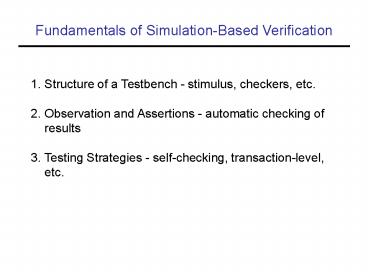Fundamentals of Simulation-Based Verification PowerPoint PPT Presentation
Title: Fundamentals of Simulation-Based Verification
1
Fundamentals of Simulation-Based Verification
- Structure of a Testbench - stimulus, checkers,
etc. - Observation and Assertions - automatic checking
of results - Testing Strategies - self-checking,
transaction-level, etc.
2
Testbench Structure
- Testbench code may have several components
3
Initiator Stimulus
Generation Component - This defines the test
abstractly Protocol Component - Converts abstract
test into bit-level detailed test
4
Generation vs Protocol Components
Generation Component Operation - Place value 64
bit value X in an address Y Protocol Component
Operation - Create detailed input signal timing
to place X into Y
- Bus Functional Model - Just the protocol
component - Transaction-Based Verification - Separating
generation from protocol
5
Responders
- Responders act approximately like a communicating
component before the component is built
6
Monitors/Checkers
Monitors only check adherence to the output
protocol - Does not look at data details ex.
Data length matches length in header
Parity of output data matches parity
bit Checkers check the correctness of the output
data also - Generally knows the expected
output ex. All outputs match predicted values
No superfluous output activity
7
Scoreboard
- Observes input signals (maybe internal too) and
records interesting information for later use
by the checker - It works closely with the checker
- Scoreboard or checker may contain the reference
model
8
Scoreboard/Checker Example
Cache design property to check The cache only
issues a request to the main store if the cache
has first received that request itself
Suppose the stimulus generates a fetch request
for location 01234500
- Scoreboard sees the input request and stores the
input data (address, cmd, etc.) - Later, the cache issues a fetch request to the
main store (a miss) - The checker sees the fetch request to the main
store - The checker asks the scoreboard if the cache has
seen a fetch request for address 01234500
9
Observable Points
- Observability refers to the variables/signals
that can be evaluated - Observability impacts test generation complexity
and test time
Example Testing a processor with broken branch
prediction
- Only occasionally impacts execution time
- May take a long time to observe at the outputs
- Can be immediately seen in the branch predictor
state bits
10
Black/White/Grey Box
- Determines whether or not observability (on
controllability) exists on internal lines
- Advantages of observing internal lines
- Faster testing
- More accurate debugging
- Disadvantages
- Depends on stability of internal lines
- Depends on understanding of design internals
- More data must be processed
11
Assertions
- A language construct that conveniently enables
simple checking - Like a checker without a complete reference model
Example (in VHDL) assert (buf_overflow / 1)
report Internal Buffer Overflow
severity ERROR
- Can observe any variable/signal
- Great for automatic checking, relatively simple
- Can be used directly capture aspects of the
specification (i.e. Internal buffer should never
overflow)
12
Testing Strategies
- Deterministic Testbenches - Predetermined input
data - Effective at revealing specific bugs
- May be very time consuming to generate tests
- Self-Checking Testbenches - Check results
automatically - Golden Vectors - Predetermined input/output data
- Very tedious to maintain
- Reference Model - Calculates expected output
on-the-fly - Hard to build, easier to update
- Transaction-Based Testbenches
- Use of abstraction in stimulus generation and
checking - Separating generation from protocol
- Output protocol recognition confined to scoreboard

